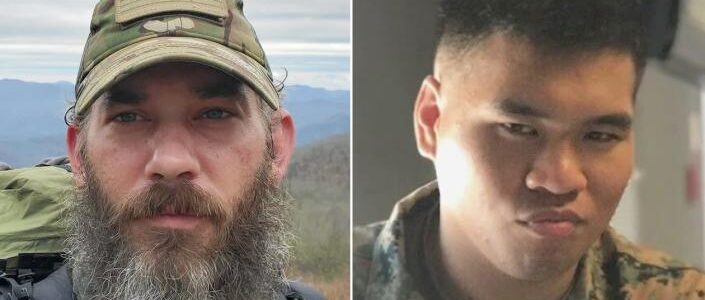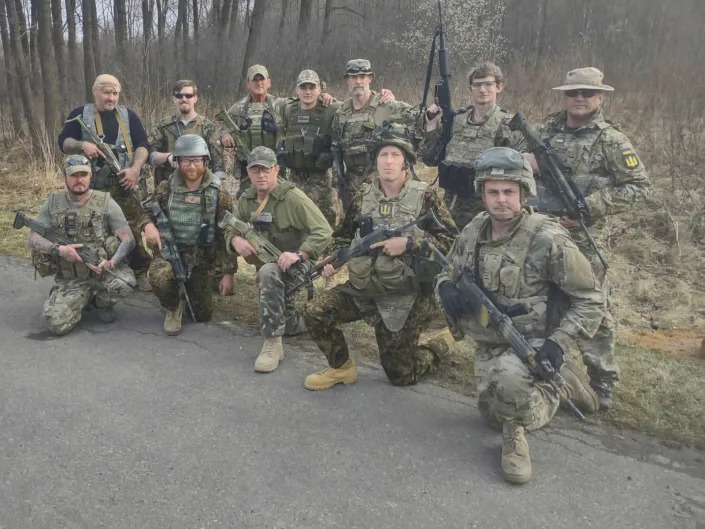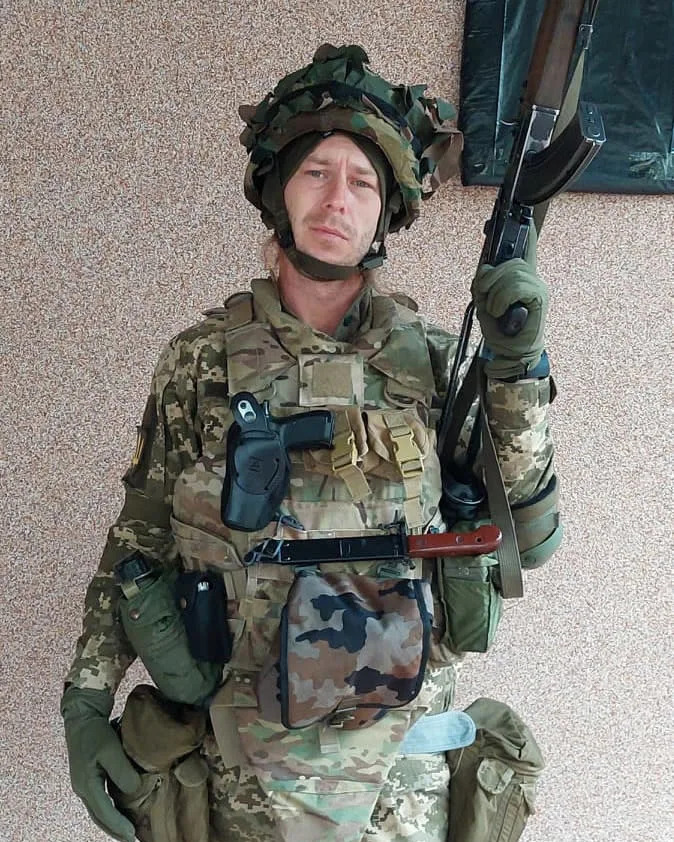
He went to Ukraine to help beat back the Russian invasion. But a moment of clumsiness, or merely a stroke of bad luck, cost Stephen D. Zabielski his life. The U.S. Army veteran was killed by a landmine in southeastern Ukraine, according to multiple sources familiar with the matter. That makes him the second American citizen to have died as a combatant in the conflict.

The U.S. State Department confirmed that Zabielski, 52, was killed in Ukraine. An obituary published by his family says that he died on May 15, 2022. Zabielski’s family was not immediately available for comment.

Ukrainian officials previously disclosed that Willy Joseph Cancel, Jr., a 22-year-old ex-Marine from Kentucky, had died in late April. A handful of Western Europeans have also died while participating in Ukraine’s loosely organized International Legion of volunteer fighters. Zabielski is the fifth western foreigner known to have been killed in combat.
Three Americans have also gone missing, and two Englishmen have been taken prisoner by the Russians, for a total of two POWs, three MIAs, and five KIAs. These ten western casualties offer a first glimpse at the composition of the International Legion that is beginning to shape up in Ukraine, after a disorderly beginning to an impromptu foreigners’ battalion that was hastily created when the Russians invaded in February.

According to the State Department, the five Americans taken prisoner or killed are all former U.S. military — two Army vets and three ex-Marines. They are representative of what appears to be the primary component of the nascent International Legion: American and UK veterans, many with substantial combat experience. Zabielski’s final days were spent in a chaotic conflict zone rife with miscommunication, confusion, and incidents of friendly fire, according to a member of his unit. And as the war grinds on with terribly heavy casualties on both sides, it’s likely that more American fighters will die.
Zabielski belonged to a squad of western volunteers, attached to the Ukrainian army, called the Wolverines, according to Tristan Nettles, a Marine Corps veteran who was with Zabielski the night he died. They were a group of thirteen English-speaking men: one Pole, one Canadian, two Brits, and eight Americans, all of whom had military experience. “Every single one,” says Nettles, who previously did a tour in Iraq. Nettles provides a photo of them posing in uniform alongside a road in Ukraine. Zabielski, in the back row, is older than the rest, but looks fit and tan.

Courtesy of Tristan Nettles
In connection with the battle of Severodonetsk, where brutal fighting remains ongoing, the Wolverines were sent on a mission to clear enemy mines. Their objective was to create a safe path for their unit’s vehicles in advance of a Ukrainian assault planned for the following morning.
There was a full moon that night, and heavy fog. Zabielski and another American fighter named Gary were to go out in front of the squad and establish an observation post. Their job was to keep watch on the Russian line, which was not far away, while the others marked the land mines for clearance.
They finished this dangerous work around two in the morning. At that point, a decision was made to postpone the next morning’s attack, due to the thick fog. That meant that Zabielski and Gary would have to maintain their observation post for another full day, even though they were all sleep-deprived. Nettles hadn’t slept in twenty-four hours. Such is the miserable life of infantrymen.
Two of the fighters made their way to the observation post to relay the order and resupply Zabielski and Gary with water and fresh batteries for their equipment. When they learned that they would have to stay out another twenty-four hours, Zabielski and Gary decided to move to a position they considered more suitable.
Nettles blames the thickness of the vegetation, the heaviness of the fog, and a failure to maintain proper distance between personnel for what happened next. “Stephen apparently triggered a trip wire, which detonated a mine that killed him and severely injured Gary,” Nettles says.
The bad news went out over the radio, and a Canadian fighter named JT drove a vehicle in the direction of the explosion to evacuate the casualties. But JT had trouble crossing some train tracks, and in an effort to get over, he made a serious mistake. He maneuvered the vehicle over a portion of the tracks that had not yet been cleared of mines. “Which resulted in his vehicle exploding with him still inside,” Nettles says.
With the sun coming up over the horizon and the Russians in close proximity, the rest of the squad had to bring the casualties out on foot. When they got to the burning vehicle on the train tracks, they found that JT, while severely injured and badly burned, was able to walk. Down where the other two guys had been hit by the land mine, they found Zabielski already dead, and Gary badly wounded, both of his legs broken below the knees.
They squad carried Gary out on a makeshift stretcher. Extraction of Zabielski’s body would have to wait for the following day. Already it was light out. “There was no security,” Nettles says. “We should have all been slaughtered, because no one had guns on the wood-line, and most everyone was being extremely loud, and we were very close to the burning vehicle right next to the Russian position. If the Russians had any tactical competence or courage at all, they would have sent a forward observation team, who would have seen our group with no weapons up, carrying a stretcher, and killed us all.”
Back at the rally point, JT and Gary were loaded into an SUV that drove hell-for-leather in the direction of the nearest hospital. On the way there, Nettles recorded a video of the wounded men. It shows Gary’s bloody legs horribly broken, the bones inside completely snapped, his pant legs shredded. He sucks in ragged breaths, moaning in agony, as the SUV jostles over a rough road. “We’re going to be there soon,” Nettles says, trying to reassure him, but his voice is shaking. JT, his head wrapped in a white bandage, appears to be conscious but in shock. The Canadian “didn’t look as bad” as Gary, but “was actually worse,” Nettles says. “He was in the car when it blew up and roasted before getting out.”
Both Gary and JT were treated at a hospital and survived their injuries. The Ukrainians sent Gary home to the United States, Nettles says, but JT “is still here, unable to walk, dealing with massive burns over most his body.”
The next day, May 16th, Zabielski’s body was taken to the local morgue. “After that, he was taken to Kyiv and handed over to the U.S. Embassy,” Nettles says. He was “flown home to Florida, where his wife held a funeral for him.”
In an email confirming Zabielski’s death, a State Department spokesperson reiterated that “U.S. citizens should not travel to Ukraine due to the active armed conflict and the singling out of U.S. citizens in Ukraine by Russian government security officials.” The State Department has repeatedly discouraged Americans from going to Ukraine to fight Russia’s invading forces. However, there is no law against it, and numerous western volunteers are there at the invitation of President Volodymyr Zelensky, who back in February announced the creation of a designated military unit for foreign fighters of all nationalities: the International Legion for the Territorial Defense of Ukraine.
Ukrainian officials claim that the International Legion has as many as twenty thousand fighters from over fifty countries. In reality, most of the foreign volunteers who initially flocked to the border of Poland to sign up were turned back, according to dozens of on-the-ground interviews that I conducted in March and April. Hardly any westerners took part in the defense of Kyiv, or the battles that ensued in late March and early April. The International Legion had been promoted with a slick advertising campaign, but had little real-world capacity to organize many hundreds of volunteers, who spoke all different languages and were wildly mismatched in their military experience, physical fitness, and psychological stability. Many of those who had hoped to join could not find any Ukrainian unit that would have them, gave up, and went home.
Cancel’s death in late April was the first indication that, two months into the war, the Ukrainians had begun to organize some of the foreigners into coherent units, and deploy them to the front lines. They have been sent out not as a freestanding foreign legion or a battalion of international fighters, but as small English-speaking squads attached to Ukrainian formations.
The two Englishmen who were forced to surrender in Mariupol, Aiden Aslin and Shaun Pinner, belonged to an earlier generation of volunteers, who had been in the Donbas since 2014. They were subjected to a show trial put on by Russia’s puppet government in Donetsk, and sentenced to death on June 9th. Their fates remain uncertain.
Zabielski was the next volunteer to die after Cancel, on May 15th. His service in the Persian Gulf War with the 101st Airborne — a storied military campaign — could not be officially confirmed by press time. Though he was 52 years old, he was not an outlier among his fellow foreign fighters. “He was an old-timer,” Nettles says, “but he never missed a beat.” He adds: “There are a lot of fifty-plus-year-old guys here.”
On June 4th, the Ukrainians disclosed the death of three European fighters, as well as a humanitarian volunteer from Australia. Ronald Vogelaar, a 55-year-old Dutchman, was killed by shelling on May 4th and buried in Kharkiv. It’s not clear where or when the other two Europeans died, but a post on the verified Facebook page of the International Legion identified them as Björn Benjamin Clavis, a German man of unknown age, and Wilfried Blerio, age 32, from Bayeaux, in Calvados, France.
On June 16th, the US State Department confirmed that three Americans had gone missing in action in Ukraine, and they all fit the profile of a well-trained combat veteran. Alexander John-Robert Drueke, age 39, from Tuscaloosa, Alabama, reportedly served two tours in Iraq with the U.S. Army. The other two who went MIA were ex-Marines: Andy Tai Ngoc Huynh, age 27, from Hartselle, Alabama; and Grady Kurpasi, a 49-year-old former infantry captain who last resided in Wilmington, North Carolina.
After having had to turn back a multitude of wannabe volunteers who were not cut out for combined-arms warfare, the Ukrainians have made it known that they will only accept volunteers with military training and actual combat experience. As a result, the International Legion that’s emerging looks a lot like a US and British auxiliary, paramilitary, or filibuster force — and certainly, Russian propaganda will portray them that way. Senior Ukrainian defense officials told me in March that the very first western volunteers to deploy to the front line were former special operations soldiers. “They are very well trained,” said Admiral Ihor Voronchenko, the inspector-general of the Ukrainian armed forces. “They have great skills.”
However, even the skills of the sort possessed by the likes of Kurpasi — the captured Marine Corps captain who did three deployments to Iraq and earned a Purple Heart in his twenty-year career — may not be enough to prepare western volunteers for the hell waiting for them on the Donbas front line. In places like Severodonetsk, Russian forces are grinding out slow territorial advances behind a punishing onslaught of artillery. Elsewhere, the Ukrainians are holding the line, or forcing the Russians to fall back. But Ukraine is losing some two hundred soldiers a day, according to what Mykhailo Podolyak, a senior aide to President Zelensky, told the BBC on June 9th. These are two modern militaries, going head to head, and no American veterans have experienced warfare of that sort, ever.
The Wolverines, the squad that Zabielski belonged to, is in disarray, Nettles says. “Only three of us remain now from the original thirteen,” he says. “The deaths and injuries have been in vain because it is an absolute shit-show out here,” he continues. “We had a two-hour firefight that later turned out to be against Ukrainian special forces. It is unbelievable what goes on here.”
Nettles, whose tour in Iraq was near Baqubah, with the 2nd Marine Division, says that his motivation for volunteering to fight in Ukraine is to bring attention to the plight of a South African woman, Ashley Oosthuizen, who is unjustly imprisoned for life in Thailand for drug crimes that she did not commit. “If it was not for Ashley,” he says, “I would not be anywhere near this ridiculous mess.”
“The media only tells one side,” he goes on. “I am here. I see the reality. Bridges blown up while friendly forces are still on the other side, no communication between units, friendly fire all the time.”
For example, Nettles says, “They tell us we have support, and then fire off three mortars and call it a day. They give a guy who has never used an automatic grenade launcher and then tell us he will be our indirect support at night from 1.2 kilometers away. I didn’t make this shit up. It is a fucking shit show. The Ukrainians are brave — I’ll say that. As for the rest, I can only shake my head as good men die for no reason at all.”
According to the obituary published by his family, Zabielski “enjoyed life to the fullest,” and liked to hunt, fish, and ride his motorcycle. Nettles says that he was of Polish descent, and a thirty-year veteran of a pipe-fitters union in upstate New York. He and his wife had recently moved down to Tampa, Florida, “He was a really good guy,” Nettles says. “Everybody liked him.”
Credit: Yahoo News
